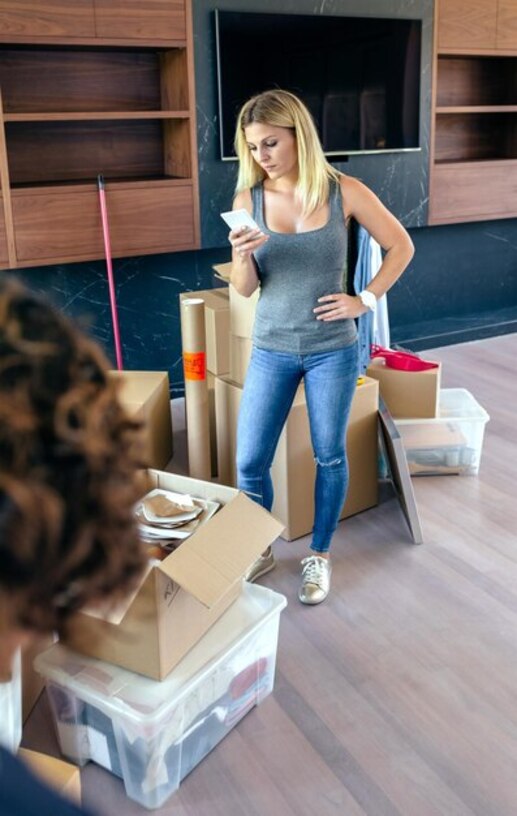Organize your move with these unexpected and useful tricks.

Organizing a move can be a true challenge, but with the unexpected and useful tricks we will present to you, this process will become a much simpler and more efficient experience. From innovative packing techniques to tips on how to coordinate the transportation of your belongings, here you will find everything you need for your move to be a success. Get ready to discover strategies that will not only save time but also money in your transition to a new home.
1. Advance planning: the first step towards a stress-free move.
Advance planning is essential for a stress-free move. Starting this process early will allow you to create a timeline that covers everything from finding boxes and packing materials to organizing transportation. By having a detailed list of tasks to complete, you can break the work into manageable stages, which not only reduces the feeling of overwhelm but also allows you to approach each aspect calmly and efficiently. Don't forget to include in your planning the notification to utilities and address changes, ensuring that everything is ready for your arrival at the new home.
By planning ahead, you will have the opportunity to get rid of items you no longer need or simply do not want to take with you. Doing a deep clean before packing not only simplifies the moving process by reducing the amount of things to be moved, but it can also be emotionally liberating. Consider organizing a garage sale or donating what you no longer use; this way you can start this new phase with a more organized and lighter home. Remember that every small step counts and contributes to making your move a much more enjoyable experience.
2. Make use of recycled boxes and other inexpensive materials.
To make your move easier without overspending, take advantage of recycled boxes and other inexpensive materials. Local stores, supermarkets, and even your neighbors can be excellent sources of boxes they no longer need. Ask these places if they have boxes available; many times they will be happy to give them to you for free. Additionally, you can use plastic containers, old suitcases, and reusable bags to pack your belongings. Not only will you save money, but you will also contribute to environmental care by giving a second life to these materials.
In addition to boxes, consider using other items you already have at home as part of the packing process. For example, old newspapers are ideal for wrapping fragile items and preventing them from breaking during transport. You can also use towels, blankets, or clothes that you don't plan to use in the short term to cushion delicate items. This strategy will not only help you reduce the amount of material you need to buy, but it will also make your move more organized and sustainable. Remember that every little effort counts when it comes to making the transition to your new home more economical and efficient.
3. The art of labeling: how to make unpacking easier
The art of labeling your boxes and belongings is a fundamental strategy to facilitate the unpacking process in your new home. When preparing your boxes, make sure to use clear and visible labels indicating the contents and the room they belong to. For example, if you are packing kitchen utensils, a label that says "Kitchen - Utensils" will not only save you time when unpacking, but it will also allow those helping you with the move to know exactly where to place each box. Use a color-coding system to quickly identify the different rooms; for example, blue for the living room, green for the bedrooms, and yellow for the kitchen. This simple technique will make your new home organized almost magically.
In addition to labeling the boxes, consider creating a digital or physical inventory where you record each packed item. This will not only give you total control over your belongings during the move, but it will also help you spot any missing items upon arriving at your new home. Be sure to include details such as the condition of the item and its specific location in the house. With this method, you will be able to unpack more quickly and efficiently, as you will have a clear reference of what is in each box without needing to open them all. With these simple yet effective labeling techniques, you will transform the chaotic process of unpacking into a streamlined and orderly activity.
4. Packaging techniques for fragile items that work
Packing fragile items can be one of the biggest challenges during a move, but with the right techniques, you can ensure that your belongings arrive at their destination safely. One of the most effective strategies is to use bubble wrap or blankets to wrap delicate items such as glassware, ceramics, and electronics. Make sure to wrap each item individually, paying special attention to corners and edges, which are the most vulnerable areas. Additionally, when placing these items in boxes, it is crucial not to overload each container; leave enough space for packing material to absorb any impact.
Another effective technique is the use of small, sturdy boxes for heavy items like books or kitchen utensils. Avoiding large boxes for these types of items not only makes transportation easier but also minimizes the risk of the box breaking under excessive weight. For very fragile items like sculptures or lamps, consider using plastic bins or buckets as a safe alternative. Fill any empty space with crumpled paper or foam to prevent movement inside the container. By following these simple yet effective techniques, you can approach your move with the confidence that your most valuable items will be protected at all times.
5. How to optimize space in your transportation vehicle
When it comes to optimizing space in your transport vehicle during a move, the key is planning and organization. First, make sure to sort your belongings by size and weight. Place the heaviest and largest items at the bottom and towards the center of the vehicle, creating a solid base that will prevent them from sliding during the trip. Use sturdy boxes and stack them strategically; for example, grouping similar items can help you maximize space usage and make it easier to access them upon arriving at your new home.
Also, do not underestimate the power of empty spaces. Fill the gaps between boxes with smaller items like rolled-up clothes or cushions; this not only helps keep everything in place but also protects your belongings from potential damage. Consider using nets or ropes to secure everything in place if you are using a large vehicle like a van or truck. With these simple techniques, you will optimize every corner of your vehicle, making for a more organized and efficient move.
6. Choose the best date to move and avoid surprises.
Choosing the best date to move can make a significant difference in the success of your relocation. Consider factors such as the time of year, days of the week, and local holidays. For example, moving during spring or fall is usually more favorable, as temperatures are moderate and there is less likelihood of facing adverse weather conditions. Additionally, avoid weekends and the beginning of the month if possible, as these are often the busiest times for moving companies and you may encounter higher prices and longer wait times.
Another key aspect is to plan ahead. If you have flexibility in your dates, book your move several weeks or even months in advance. This will not only allow you to secure a good price on moving services, but it will also give you time to coordinate all the logistical details without rushing. Additionally, consider reaching out to friends and family to schedule their help on moving day; choosing a day that works for them will facilitate a smoother and less stressful transition. With good timing planning, you can avoid unpleasant surprises that complicate your move.
7. Transportation services: when to hire professional help?
When it comes to moving, the transport of your belongings is one of the most critical aspects of the process. While you can choose to do it yourself, there are times when hiring professional help becomes the best decision. For example, if you have heavy or bulky furniture that requires specific tools and expertise to be transported without damage, having a specialized team can save you not only physical effort but also potential injuries and additional costs for damages to your items. Furthermore, moving companies often have suitable and secure vehicles to effectively transport your belongings. Another determining factor is the distance between your old and new home. If you are making a long-distance move or even an international one, customs regulations and complex logistics can significantly complicate the process. In these cases, transportation experts have the necessary knowledge to handle all the legal and logistical aspects involved, allowing you to focus on other important details of your move. Evaluating the emotional and physical toll that this change entails can also make you reconsider whether it is truly worth taking on all the work yourself or if it would be wiser to delegate it to professionals who ensure a smooth and trouble-free transition.
8. Take advantage of technology: useful apps to organize your move
Leveraging technology can completely transform the moving experience. There are mobile applications specifically designed to help organize every step of the process, from initial planning to unpacking in your new home. Apps like "MoveAdvisor" allow you to create personalized task lists, manage schedules, and track progress, helping you keep everything under control. Additionally, some of these tools offer automatic reminders so you don't miss any important details and can focus on what matters.
Another useful category is inventory apps that make it easier to catalog your belongings before packing them. Using apps like "Sortly" or "Moving Organizer," you can take photos and add descriptions to each box, which is especially handy when it comes time to unpack. This way, you will know exactly where each item is without having to open all the boxes. By integrating these technological solutions into your move, you can optimize time and reduce stress, turning this phase into a much smoother and more organized process.
9. Get rid of the unnecessary: tips for decluttering before moving.
Getting rid of the unnecessary is one of the most liberating and essential steps before moving. Start with an honest assessment of your belongings: Do you really need everything you have? Apply the three-box method: one for keeping, another for donating, and a third for discarding. This approach will help you quickly sort through what you truly value and what no longer has a place in your life. Additionally, consider a time limit; if you haven't used an item in over six months, it's likely you won't need it in your new home.
Another useful tip is to involve the whole family in the decluttering process. Assign each member the task of reviewing their own spaces and personal belongings. Not only will this make the process faster, but it will also encourage reflection on what each person truly wants to keep. Finally, remember that getting rid of things not only lightens your physical load but can also be an emotional relief. By letting go of unnecessary items, you are creating both physical and mental space for new experiences and memories in your new home.
10. Post-move tips: how to quickly adapt to your new home
Adapting to a new home can be an overwhelming experience, but with some practical tips, you can feel comfortable in your space quickly. First, it's essential to establish a welcoming environment. Start by unpacking the most essential boxes and placing your personal items in visible spots. Family photos, decorations you like, and your favorite books can transform any room and make you feel more connected to your new surroundings. Additionally, try to organize each area of the house by function; for example, create a reading nook or a workspace that reflects your personal style.
Another crucial aspect for adapting quickly is to familiarize yourself with the neighborhood. Take the time to explore the surroundings: visit local shops, cafes, and nearby parks. Getting to know your neighbors can also make adaptation easier; don't hesitate to introduce yourself and build friendly relationships. Participating in community activities or local events can help you integrate faster and feel like part of the place. Remember that every move is an opportunity to start anew, so maintain a positive and open attitude while building your new life in this renewed space.



